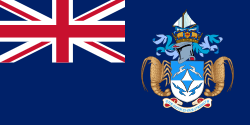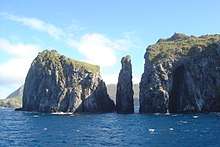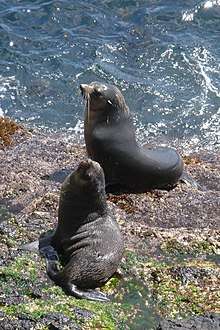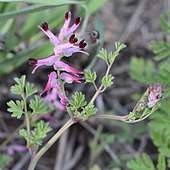Tristan da Cunha
Tristan da Cunha (/ˌtrɪstən də ˈkuːn(j)ə/), colloquially Tristan, is a remote group of volcanic islands in the south Atlantic Ocean. It is the most remote inhabited archipelago in the world, lying approximately 1,511 miles (2,432 km) off the coast of Cape Town in South Africa, 1,343 miles (2,161 km) from Saint Helena and 2,166 miles (3,486 km) off the coast of the Falkland Islands.[5][6]
Tristan da Cunha | |
|---|---|
| Motto(s): "Our faith is our strength" | |
| Anthem: "God Save the Queen" | |
| Territorial song: "The Cutty Wren" | |
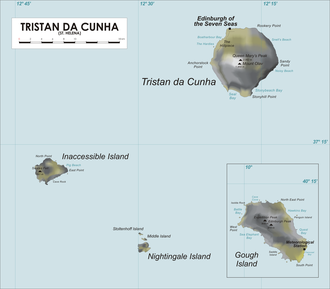 Map of Tristan da Cunha | |
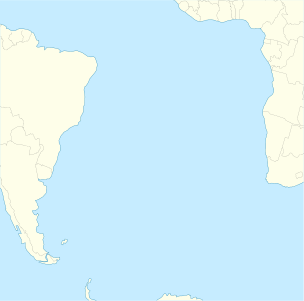 Location of Tristan da Cunha archipelago (circled in red) in the southern Atlantic Ocean | |
| Sovereign state | United Kingdom |
| First settlement | 1810 |
| Dependency of Cape Colony | 14 August 1816[1] |
| Dependency of Saint Helena | 12 January 1938 |
| Current constitution | 1 September 2009 |
| Capital and largest settlement | Edinburgh of the Seven Seas 37°4′S 12°19′W |
| Official languages | English |
| Demonym(s) | Tristanian |
| Government | Devolved locally governing dependency under a constitutional monarchy |
• Monarch | Elizabeth II |
• Governor | Philip Rushbrook |
| Fiona Kilpatrick and Stephen Townsend (job share) | |
| James Glass[2] | |
| Legislature | Island Council |
| Government of the United Kingdom | |
• Minister | Tariq Ahmad |
| Area | |
• Total | 207 km2 (80 sq mi) |
• Main island | 98 km2 (38 sq mi) |
| Highest elevation | 6,765 ft (2,062 m) |
| Population | |
• 2019 estimate | 246[3] |
• 2016 census | 293[4] |
• Density | 1.4/km2 (3.6/sq mi) |
| Currency | Pound sterling (£) (GBP) |
| Time zone | UTC±00:00 (GMT) |
| Date format | dd/mm/yyyy |
| Driving side | left |
| Calling code | |
| UK postcode | TDCU 1ZZ |
| ISO 3166 code | SH-TA |
| Internet TLD | |
The territory consists of the inhabited island, Tristan da Cunha, which has a diameter of roughly 11 kilometres (6.8 mi) and an area of 98 square kilometres (38 sq mi), and the wildlife reserves of Gough Island and Inaccessible Island and the smaller, uninhabited Nightingale Islands. As of October 2018, the main island has 250 permanent inhabitants who all carry British Overseas Territories citizenship.[3] The other islands are uninhabited, except for the South African personnel of a weather station on Gough Island.
Tristan da Cunha is a British Overseas Territory with its own constitution.[7] There is no airstrip of any kind on the main island; the only way of travelling in and out of Tristan is by boat, a six-day trip from South Africa.[8]
History
Discovery
_(cropped2).jpg)
The islands were first recorded as sighted in 1506 by Portuguese explorer Tristão da Cunha, though rough seas prevented a landing. He named the main island after himself, Ilha de Tristão da Cunha. It was later anglicised from its earliest mention on British Admiralty charts to Tristan da Cunha Island. Some sources state that the Portuguese made the first landing in 1520, when the Lás Rafael captained by Ruy Vaz Pereira called at Tristan for water.[9]
The first undisputed landing was made on 7 February 1643 by the crew of the Dutch East India Company ship Heemstede, captained by Claes Gerritsz Bierenbroodspot. The Dutch stopped at the island four more times in the next 25 years, and in 1656 created the first rough charts of the archipelago.[10]
The first full survey of the archipelago was made by crew of the French corvette Heure du Berger in 1767. The first scientific exploration was conducted by French naturalist Louis-Marie Aubert du Petit-Thouars, who stayed on the island for three days in January 1793, during a French mercantile expedition from Brest, France to Mauritius. Thouars made botanical collections and reported traces of human habitation, including fireplaces and overgrown gardens, probably left by Dutch explorers in the 17th century.[10]
On his voyage out from Europe to East Africa and India in command of the Imperial Asiatic Company of Trieste and Antwerp ship, Joseph et Therese, William Bolts sighted Tristan da Cunha, put a landing party ashore on 2 February 1777 and hoisted the Imperial flag, naming it and its neighboring islets the Isles de Brabant.[11][12] In fact, no settlement or facilities were ever set up there by the company.
After the British Government announced in September 1786 that it would proceed with the settlement of New South Wales, Alexander Dalrymple, presumably goaded by Bolts's actions, published a pamphlet[13] with an alternative proposal of his own for settlements on Tristan da Cunha, St. Paul and Amsterdam islands in the Southern Ocean.
Captain John Blankett, R.N., also suggested independently to his superiors in August 1786 that convicts be used to establish an English settlement on Tristan.[15] In consequence, the Admiralty received orders from Government in October 1789 to examine the island as part of a general survey of the South Atlantic and the coasts of southern Africa.[16] That did not happen, but an investigation of Tristan, Amsterdam and St. Paul was undertaken in December 1792 and January 1793 by George Macartney, Britain's first ambassador to China. During his voyage to China he established that none of the islands were suitable for settlement.[17]
19th century
The first permanent settler was Jonathan Lambert of Salem, Massachusetts, United States, who moved to the island in December 1810 with two other men, and later a third.[18] Lambert publicly declared the islands his property and named them the Islands of Refreshment. Three of the four men died in 1812; however, the survivor among the original three permanent settlers, Thomas Currie (or Tommaso Corri) remained as a farmer on the island.[19]
On 14 August 1816, the United Kingdom annexed the islands, making them a dependency of the Cape Colony in South Africa. This was explained as a measure to prevent the islands' use as a base for any attempt to free Napoleon Bonaparte from his prison on Saint Helena.[20] The occupation also prevented the United States from using Tristan da Cunha as a base for naval cruisers, as it had during the War of 1812.[18] Possession was abandoned in November 1817, although some members of the garrison, notably William Glass, stayed and formed the nucleus of a permanent population.
Edmund Roberts, Embassy to the Eastern Courts of Cochin-China, Siam, and Muscat, 1837
The islands were occupied by a garrison of British Marines, and a civilian population gradually grew. Berwick stopped there on 25 March 1824 and reported that it had a population of twenty-two men and three women. The barque "South Australia" stayed there on 18–20 February 1836 when a certain Glass was Governor, as reported in a chapter on the island by W. H. Leigh.[21]
Whalers set up bases on the islands for operations in the Southern Atlantic. However, the opening of the Suez Canal in 1869, together with the gradual transition from sailing ships to coal-fired steam ships, increased the isolation of the islands, which were no longer needed as a stopping port for lengthy sail voyages, or for shelter for journeys from Europe to East Asia.[18] A parson arrived in February 1851, the Bishop of Cape Town visited in March 1856 and the island was included within the diocese of Cape Town.[22]:63–50
In 1867, Prince Alfred, Duke of Edinburgh and second son of Queen Victoria, visited the islands. The main settlement, Edinburgh of the Seven Seas, was named in honour of his visit.[lower-alpha 1] On 15 October 1873, the Royal Navy scientific survey vessel HMS Challenger docked at Tristan to conduct geographic and zoological surveys on Tristan, Inaccessible Island and the Nightingale Islands.[24] In his log, Captain George Nares recorded a total of fifteen families and eighty-six individuals living on the island.[25] Tristan became a dependency of the British Crown in October 1875.[26]
20th century
After years of hardship since the 1880s and an especially difficult winter in 1906, the British government offered to evacuate the island in 1907. The Tristanians held a meeting and decided to refuse, despite the crown's warning that it could not promise further help in the future.[9] No ships called at the islands from 1909 until 1919, when HMS Yarmouth finally stopped to inform the islanders of the outcome of World War I.[27] The Shackleton–Rowett Expedition stopped in Tristan for five days in May 1922, collecting geological and botanical samples before returning to Cape Town.[9] Among the few ships that visited in the coming years were the RMS Asturias, a Royal Mail Steam Packet Company passenger liner, in 1927, and the ocean liners RMS Empress of France in 1928,[28] RMS Duchess of Atholl in 1929,[29] and RMS Empress of Australia in 1935.[30][31] In 1936, The Daily Telegraph of London reported the population of the island was 167 people, with 185 cattle and 42 horses.[32]
From December 1937 to March 1938, a Norwegian party made a dedicated scientific expedition to Tristan da Cunha, and sociologist Peter A. Munch extensively documented island culture — he would later revisit the island in 1964–1965.[33] The island was also visited in 1938 by W. Robert Foran, reporting for the National Geographic Society.[34] Foran's account was published that same year.[35] On 12 January 1938 by letters patent, Britain declared the islands a dependency of Saint Helena, creating the British Crown Colony of Saint Helena and Dependencies, which also included Ascension Island.[36]
During the Second World War, Tristan was commissioned by the Royal Navy as the stone frigate HMS Atlantic Isle and used as a secret signals intelligence station to monitor Nazi U-boats (which were required to maintain radio contact) and shipping movements in the South Atlantic Ocean. This weather and radio station led to extensive new infrastructure being built on the island, including a school, a hospital, and a cash-based general store. The first colonial official sent to rule the island was Sir Hugh Elliott in the rank of Administrator (because the settlement was too small to merit a Governor) 1950-53. Development continued as the island's first canning factory expanded paid employment in 1949.[37] Prince Philip, Duke of Edinburgh, the Queen's consort, visited the islands in 1957 as part of a world tour on board the royal yacht HMY Britannia.[38]
On 2 January 1954 Tristan da Cunha was visited by the M.V. Ruys, a civilian freighter carrying science fiction writer Robert A Heinlein, his wife Ginny and other passengers. The Ruys was traveling from Rio De Janeiro, Brazil to Cape Town South Africa. The visit is described in Heinlein's book Tramp Royal. The captain told Heinlein the island was the most isolated inhabited spot on Earth and ships rarely visited. Heinlein mailed a letter there to L. Ron Hubbard, a friend who also liked to travel, "for the curiosity value of the postmark." Biographer William H Patterson, Jr. in his two volume "Robert A Heinlein In Dialogue with his Century," wrote that lack of "cultural context" made it "nearly impossible to converse" with the islanders, "a stark contrast with the way they had managed to chat with strangers" while traveling in South America. Members of the crew bought penguins during their brief visit to the island.
On 10 October 1961, the eruption of Queen Mary's Peak forced the evacuation of the entire population of 264 individuals.[39][40] Evacuees took to the water in open boats and sailed to uninhabited Nightingale Island, where they were picked up by a Dutch passenger ship that took them via Cape Town to Britain. The islanders arrived in the UK to a big press reception, and were settled in an old Royal Air Force camp near Calshot, Hampshire.[40] The following year a Royal Society expedition reported that Edinburgh of the Seven Seas had survived the eruption. Most families returned in 1963.[41]
Gough Island was inscribed as a UNESCO World Heritage Site in 1995, then named "Gough Island Wildlife Reserve".[42] The site was extended in 2004 to include the neighbouring Inaccessible Island and renamed Gough and Inaccessible Islands, with its marine zone extended from 3 to 12 nautical miles. The Gough and Inaccessible Islands were declared as separate Ramsar sites — wetland sites designated to be of international importance — on 20 November 2008.[43][44]
21st century
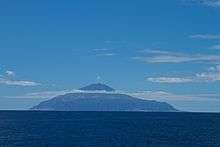
On 23 May 2001, the islands were hit by an extratropical cyclone that generated winds up to 190 kilometres per hour (120 mph). A number of structures were severely damaged, and numerous cattle were killed, prompting emergency aid provided by the British government.[45] In 2005, the islands were given a United Kingdom post code (TDCU 1ZZ), to make it easier for the residents to order goods online.[46]
On 13 February 2008, a fire destroyed the island's four power generators and fish canning factory, severely disrupting the economy. On 14 March 2008, new generators were installed and power restored, and a new factory opened in July 2009. While the replacement factory was built, M/V Kelso came to the island as a factory ship.[47][48] The St. Helena, Ascension, and Tristan da Cunha Constitution Order 2009 reorganized Tristan da Cunha as a constituent of the new British Overseas Territory of Saint Helena, Ascension and Tristan da Cunha, giving Tristan and Ascension equal status with Saint Helena.[7]
On 16 March 2011, the freighter MS Oliva ran aground on Nightingale Island, spilling tons of heavy fuel oil into the ocean. The resulting oil slick threatened the island's population of rockhopper penguins.[49] Nightingale Island has no fresh water, so the penguins were transported to Tristan da Cunha for cleaning.[50]
A total solar eclipse will pass over the island on 5 December 2048. The island is calculated to be on the centre line of the umbra's path for nearly three and a half minutes of totality.[51]
Geography
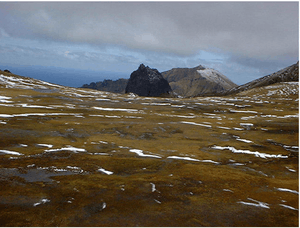
Tristan da Cunha is thought to have been formed by a long-lived centre of upwelling mantle called the Tristan hotspot. Tristan da Cunha is the main island of the Tristan da Cunha archipelago, which consists of the following islands:
- Tristan da Cunha, the main and largest island, area: 98 square kilometres (37.8 sq mi)[52] (37°6′44″S 12°16′56″W)
- Inaccessible Island, area: 14 square kilometres (5.4 sq mi)
- Nightingale Islands, area: 3.4 square kilometres (1.3 sq mi)
- Nightingale Island, area: 3.2 square kilometres (1.2 sq mi)
- Middle Island, area: 0.1 square kilometres (25 acres)
- Stoltenhoff Island, area: 0.1 square kilometres (25 acres)
- Gough Island (Diego Alvarez), area: 91 square kilometres (35 sq mi)[53]
Inaccessible Island and the Nightingale Islands are 35 kilometres (22 mi) SW by W and SSW away from the main island, respectively, whereas Gough Island is 395 kilometres (245 mi) SSE.
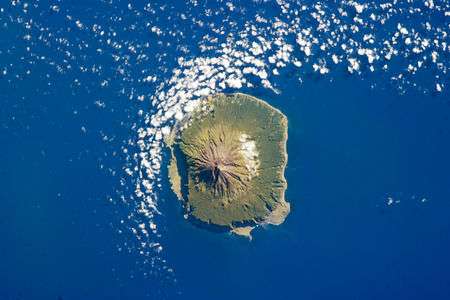
The main island is generally mountainous. The only flat area is on the north-west coast, which is the location of the only settlement, Edinburgh of the Seven Seas. The highest point is the summit of a volcano called Queen Mary's Peak at an elevation of 2,062 metres (6,765 ft), high enough to develop snow cover in winter. The other islands of the group are uninhabited, except for a weather station with a staff of six on Gough Island, which has been operated by South Africa since 1956 and has been at its present location at Transvaal Bay on the southeast coast since 1963.[54][55]
Climate
The archipelago has a Cfb, wet oceanic climate, under the Köppen system, with mild temperatures and very limited sunshine but consistent moderate-to-heavy rainfall due to the persistent westerly winds.[56] Under the Trewartha classification, Tristan da Cunha has a humid subtropical climate due to the lack of cold weather. The number of rainy days is comparable to the Aleutian Islands at a much higher latitude in the northern hemisphere, while sunshine hours are comparable to Juneau, Alaska, 20° farther from the equator. Frost is unknown below elevations of 500 metres (1,600 ft), and summer temperatures are similarly mild, never reaching 25 °C (77 °F). Sandy Point on the east coast is reputed to be the warmest and driest place on the island, being in the lee of the prevailing winds.[57]
| Climate data for Tristan da Cunha | |||||||||||||
|---|---|---|---|---|---|---|---|---|---|---|---|---|---|
| Month | Jan | Feb | Mar | Apr | May | Jun | Jul | Aug | Sep | Oct | Nov | Dec | Year |
| Record high °C (°F) | 23.7 (74.7) |
24.4 (75.9) |
24.4 (75.9) |
22.4 (72.3) |
20.3 (68.5) |
18.7 (65.7) |
17.8 (64.0) |
17.3 (63.1) |
17.1 (62.8) |
18.4 (65.1) |
20.4 (68.7) |
21.8 (71.2) |
24.4 (75.9) |
| Average high °C (°F) | 20.4 (68.7) |
21.2 (70.2) |
20.5 (68.9) |
18.9 (66.0) |
16.9 (62.4) |
15.3 (59.5) |
14.4 (57.9) |
14.2 (57.6) |
14.3 (57.7) |
15.4 (59.7) |
17.0 (62.6) |
18.9 (66.0) |
17.3 (63.1) |
| Daily mean °C (°F) | 17.9 (64.2) |
18.8 (65.8) |
17.9 (64.2) |
15.4 (59.7) |
14.6 (58.3) |
13.1 (55.6) |
12.2 (54.0) |
11.9 (53.4) |
12.0 (53.6) |
13.0 (55.4) |
14.6 (58.3) |
16.5 (61.7) |
14.8 (58.6) |
| Average low °C (°F) | 15.4 (59.7) |
16.2 (61.2) |
15.3 (59.5) |
11.9 (53.4) |
12.3 (54.1) |
10.9 (51.6) |
10.0 (50.0) |
9.6 (49.3) |
9.7 (49.5) |
10.6 (51.1) |
12.2 (54.0) |
14.1 (57.4) |
12.4 (54.3) |
| Record low °C (°F) | 10.9 (51.6) |
11.8 (53.2) |
10.3 (50.5) |
9.5 (49.1) |
7.4 (45.3) |
6.3 (43.3) |
4.8 (40.6) |
4.6 (40.3) |
5.1 (41.2) |
6.4 (43.5) |
8.3 (46.9) |
9.7 (49.5) |
4.6 (40.3) |
| Average rainfall mm (inches) | 93 (3.7) |
113 (4.4) |
121 (4.8) |
129 (5.1) |
155 (6.1) |
160 (6.3) |
160 (6.3) |
175 (6.9) |
169 (6.7) |
151 (5.9) |
128 (5.0) |
127 (5.0) |
1,681 (66.2) |
| Average rainy days | 18 | 17 | 17 | 20 | 23 | 23 | 25 | 26 | 24 | 22 | 18 | 19 | 252 |
| Average relative humidity (%) | 79 | 77 | 75 | 78 | 78 | 79 | 79 | 79 | 78 | 79 | 79 | 80 | 78 |
| Mean monthly sunshine hours | 139.5 | 144.0 | 145.7 | 129.0 | 108.5 | 99.0 | 105.4 | 105.4 | 120.0 | 133.3 | 138.0 | 130.2 | 1,498 |
| Percent possible sunshine | 31 | 35 | 38 | 38 | 35 | 34 | 34 | 32 | 33 | 33 | 32 | 29 | 34 |
| Source 1: Worldwide Bioclimatic Classification System[58] | |||||||||||||
| Source 2: Climate and Temperature[59][60] | |||||||||||||
Flora and fauna
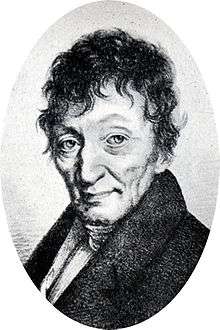
Many of the flora and fauna of the archipelago have a broad circumpolar distribution in the South Atlantic and South Pacific Oceans. For example, the plant species Nertera depressa was first collected in Tristan da Cunha,[61] but has since been recorded as far away as New Zealand.[62]
Invasive species
The islands of Tristan da Cunha has a high significance of global biodiversity as the island is considered a natural World Heritage Site. This designation is largely due to the seabird population found on the archipelago. The biodiversity of the island is on the decline because of the introduction of invasive species. Due to Tristan da Cunha's isolated archipelago ecology, and increase of tourism with cruise ships and research vessels, more invasive species are set to be introduced to Tristan da Cunha.[63] The islands' vegetation and mammal species are not equipped to defend against or control introduced species, increasing island vulnerability, due to lack of defensive behavioral mechanisms and slow generational output rates. Efforts to decrease and eradicate invasive flora, fauna, and marine species are in the works and have yet to show any successful outcomes. The following described invasive species have been known to have harmful effects on the islands' vegetation and native species.
Flora
Native plants
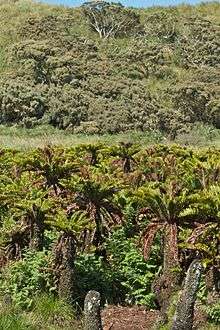
_(9126480547).jpg)
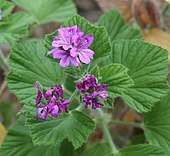
A combination of the list on Kew's Plants of the World Online site with information from a paper by Wace and Holdgate[64] yields the following list (by no means exhaustive) of plant species recorded as native to Tristan da Cunha.
- Atriplex plebeia Carmich. (Amaranthaceae)
- Dysphania tomentosa (Thouars) Mosyakin & Clemants (Amaranthaceae)
- Apium australe Thouars (Apiaceae)
- Hydrocotyle capitata Thouars (Araliaceae)
- Chevreulia sarmentosa (Pers.) S.F.Blake (Asteraceae)
- Cotula goughensis Rud. Brown (Asteraceae)
- Cotula moseleyi Hemsl. (Asteraceae)
- Gamochaeta thouarsii (Spreng.) Anderb. (Asteraceae)
- Gnaphalium thouarsii Spreng. (Asteraceae)
- Empetrum rubrum Vahl ex Willd. (Ericaceae)
- Sophora macnabiana (Graham) Skottsb. (Fabaceae)
- Pelargonium cucullatum (L.) L'Hér. (Geraniaceae)
- Pelargonium grossularioides (L.) L'Hér. (Geraniaceae)
- Callitriche christensenii Christoph. (Plantaginaceae)
- Rumex frutescens Thouars (Polygonaceae)
- Phylica arborea Thouars (Rhamnaceae)
- Nertera granadensis Druce (Rubiaceae)
- Agrostis carmichaelii Schult. & Schult.f. (Poaceae)
- Agrostis crinum-ursi Mez (Poaceae)
- Agrostis media Carmich. (Poaceae)
- Agrostis trachychlaena C.E. Hubbard (Poaceae)
- Deschampsia wacei C.E.Hubb. (Poaceae)
- Sporobolus mobberleyanus P.M.Peterson & Saarela (Poaceae)
- Rostkovia tristanensis Christoph. (Juncaceae)
- Carex insularis Carmich. (Cyperaceae)
- Carex thouarsii Carmich. (Cyperaceae)
- Isolepis bicolor Carmich. (Cyperaceae)
- Isolepis moseleyana (Boeckeler) Muasya (Cyperaceae)
- Isolepis prolifera (Rottb.) R.Br. (Cyperaceae)
- Isolepis sulcata (Thouars) Carmich. (Cyperaceae)
Ferns, Mosses and Clubmosses
- Asplenium aequibasis (C.Chr.) J.P.Roux (Aspleniaceae)
- Asplenium alvarezense Rudm. Brown (Aspleniaceae)
- Athyrium medium (Carmich.) T.Moore (Athyriaceae)
- Austroblechnum penna-marina (Poir.) Gasper & V.A.O.Dittrich (Blechnaceae)
- Blechnum palmiforme (Thouars) C.Chr. (Blechnaceae)
- Elaphoglossum laurifolium (Thouars) T.Moore (Dryopteridaceae)
- Rumohra adiantiformis (G.Forst.) Ching (Dryopteridaceae)
- Polyphlebium angustatum (Carmich.) Ebihara & Dubuisson (Hymenophyllaceae)
- Notogrammitis billardierei (Willdenow) Parris (Polypodiaceae)
- Lycopodium diaphanum (P.Beauv.) Sw. (Lycopodiaceae)
- Racomitrium lanuginosum (Hedw.) Brid. (Grimmiaceae)[65]
Introduced plants
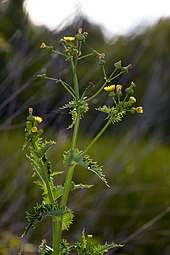
The remote island of Tristan da Cunha acquired an estimated 137 non-native vascular plants that can be categorized into four species types; weeds (trees, shrubs, agricultural weeds), grassland species (grasses), garden escapes (vegetables), and other ruderal species.[66] Vascular plants were accidentally introduced in a variety of ways including; impurities in flower or vegetable seeds, seeds or plant fragments from other imported plants and in soil, attached to containers, cars or people.[66] The majority of invasive weed species that has been introduced to the island are spread by seed and cover 50% of arable land in widely distributed patches.[66] These species include prickly sow-thistle (Sonchus asper), smooth sow-thistle (Sonchus oleraceus), smooth hawksbeard (Crepis capillaris), scrambling fumitory (Fumaria muralis), green field speedwell (Veronica agrestis), groundsel (Senecio vulgaris), and nutgrass (Cyperus esculentus).[66] Other invasive weed species that have a more localized distribution in plots include prickly sow-thistle (Sonchus asper), smooth sow-thistle (Sonchus oleraceus), smooth hawksbeard (Crepis capillaris), and groundsel (Senecio vulgaris).[66] Whether a species is distributed locally or widely depends on the seed's dispersal mechanisms; larger seeds that have not adapted to wind dispersal will be distributed locally, while smaller seeds have adapted to wind dispersal will be widely distributed.[66]
The invasive plants have had several negative impacts on native island plant species, including the competitive exclusion of many such species.[66] The out-competition will and can alter the structure of plant communities and the quality of the islands' soil. Introduced vegetation has altered long-term carbon storage as well as the reduction of CO2 in the atmosphere.[66] Native plants such as fern bushes, Phylica bushes, fern brakes, mires, and bogs, contain high organic content matter which functions as storage for carbon.[66] With the introduction of harmful species, the islands will see a decrease in carbon storage of both the soil and vegetation. With multiple changes occurring within the soil due to invasive plant species, the nutrient cycle is bound to be negatively influenced. Invasive plants are also affecting the human population of Tristan da Cunha by being disease carriers and becoming agricultural pests in gardens and pastures.[66]
The alien plants are able to survive and continue to grow and spread successfully on the islands because they have the ability to naturalize in temperate regions and have limited necessities needed to survive.[66] The islands' isolation increases archipelago ecology uniqueness which increases susceptibility for foreign invaders.[63] A small human population with minimal development encourages flora and fauna development within a limited food web which increases the invasive species abilities for self-defense.[63]
Plants are being controlled by taking surveys of the invasive species, evaluating their impact on biodiversity, and evaluating the feasibility of their eradication.[67] It would be nearly impossible to try and eradicate all invasive plant species so scientists are narrowing down to control particular species based on their impact and feasibility to eradicate. Mitigation plans that are taking place on Tristan are time-consuming and labor-intensive that will take several years using mechanical and chemical procedures.[63]
Fauna
Land
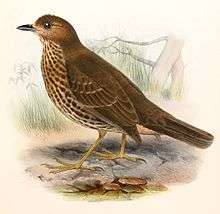
Tristan is primarily known for its wildlife. The island has been identified as an Important Bird Area by BirdLife International because there are 13 known species of breeding seabirds on the island and two species of resident land birds. The seabirds include northern rockhopper penguins, Atlantic yellow-nosed albatrosses, sooty albatrosses, Atlantic petrels, great-winged petrels, soft-plumaged petrels, broad-billed prions, grey petrels, great shearwaters, sooty shearwaters, Tristan skuas, Antarctic terns and brown noddies.[68] Tristan and Gough Islands are the only known breeding sites in the world for the Atlantic petrel. Inaccessible Island is also the only known breeding ground of the spectacled petrel.[69] The Tristan albatross is known to breed only on Gough and Inaccessible Islands: all nest on Gough, except for one or two pairs which nest on Inaccessible Island.[70]
The endemic Tristan thrush, also known as the "starchy", occurs on all of the northern islands and each has its own subspecies, with Tristan birds being slightly smaller and duller than those on Nightingale and Inaccessible. The endemic Inaccessible Island rail, the smallest extant flightless bird in the world, is found only on Inaccessible Island. In 1956, eight Gough moorhens were released at Sandy Point on Tristan, and have subsequently colonised the island.[71] No birds of prey breed on Tristan da Cunha, but the Amur falcon occasionally passes through the area on its migrations, thus putting it on the island's bird list.
A non-native species of house mice that have evolved to be 50% larger than average house mice have adapted to Tristan da Cunha. They are thought to have been accidentally introduced by 19th century seal hunters who would dock on the islands.[67] These mice have adapted by consuming sea bird eggs and chicks (as they nest on the ground), killing an estimated 2 million chicks annually pushing the species to extinction. Gathering at night in groups of 9 or 10, the mice gather at the bird's nest to feast. With no natural predators, the invasive mice population is able to expand by producing new generations twice a year. With no natural predators and a high generational output rate, there is no way to control the growth of the invasive mice population. The native bird species have slower generational output and exposure to the islands.[67]
Mitigation plans in order to eradicate or decrease the invasive rodent population on the islands was seriously discussed in March 2008 taking into consideration the islands' community. Discussion of aerial bait drop on Tristan brought up concerns of health and safety of the children, livestock and the security of the water supply.[72] Because the proposed plans for mitigation were not fully agreed upon by the Tristan community, eradication methods were shelved until 2019.
In order to prevent the growth of the invasive mice population and extinction of the Albatross bird species, a 2019 Gough Island mouse eradication project was announced (Grundy, 2018). The RSPB and Tristan da Cunha Government have partnered to spread cereal pellets with rodenticide bait across the Gough Island's, in hopes to eradicate the invasive mice population.[73] This solution plan may seem simple but can become complex when discussing dispersal methods, which is predicted to be by helicopter, because of the island's remote location and harsh weather conditions.[73] In areas that are hard to reach by helicopter, pellets will be scattered by hand.[73] The goal of this operation is to restore Tristan da Cunha back to its natural state, ensuring it will still be one of the world's most important seabird nesting sites.[73] Other methods that may be more simple, such as introducing cats, would pose a greater threat to the fragile bird populations as they would likely to prey on the birds as well and cats have already been eradicated from the islands.[74]
Marine
The biodiversity of marine life is limited given the islands' isolation, making identifying the impacts of invasion difficult.[75] While much of the marine life is unknown there has been an invasive species identified in the waters around the islands. This species includes the South American silver porgy (Diplodus argenteus argenteus) which is thought to have seek refuge in the area due to the wreck of an oil platform off the coast of Tristan in 2006.[75] The silver porgy is omnivorous but is not linked to the consumption of the valued lobster populations that the islanders fish.[75] The silver porgy is however suspected to be consuming components of the islands’ fragile kelp forest.[75] The kelp forest is extremely limited in biodiversity and has a simple, short-chain food web.[75] While this species is considered non-native and invasive, removal efforts are currently not prioritized.[75] Continued monitoring is suggested and expedition research for all invasive marine species are ongoing.[75]
Various species of whales and dolphins can be seen around Tristan from time to time with increasing sighting rates, although recovery of baleen whales, especially the southern right whale, were severely hindered by illegal whaling by the Soviet Union in the aftermath of the 1960 volcanic eruption.[76] The subantarctic fur seal Arctocephalus tropicalis can also be found in the Tristan archipelago, mostly on Gough Island.[77]
Economy
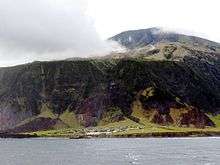
The island has a unique social and economic structure in which all resident families farm and all land is communally owned. Outsiders are prohibited from buying land or settling on Tristan. Besides subsistence agriculture, major industries are commercial fishing and government. Major export industries are the Tristan rock lobster (Jasus) fishery, the sale of the island's postage stamps and coins, and limited tourism.[78] Like most British Overseas Territories, it was never a part of the European Union, but was a member of the EU's Overseas Countries and Territories Association.[79]
The Bank of Saint Helena was established on Saint Helena and Ascension Island in 2004. This bank does not have a physical presence on Tristan da Cunha, but residents of Tristan are entitled to its services.[80] Although Tristan da Cunha is part of the same overseas territory as Saint Helena, it does not use the local Saint Helena pound, instead using the United Kingdom issue of the pound sterling.[81]
The island is located in the South Atlantic Anomaly, an area of the Earth with an abnormally weak magnetic field. On 14 November 2008 a geomagnetic observatory was inaugurated on the island as part of a joint venture between the Danish Meteorological Institute and DTU Space.[82]
Transport
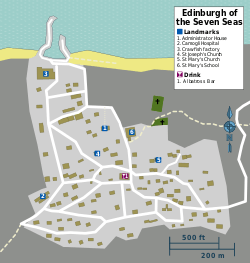
The remote location of the islands makes transport to the outside world difficult. Tristan da Cunha has no airstrip and is not generally accessible to air travel, though the wider territory is served by Saint Helena Airport[83][84] and RAF Ascension Island.[85] Fishing boats from South Africa service the islands eight or nine times per year.
The RMS Saint Helena used to connect the main island to St Helena and South Africa once each year during its January voyage, but has done so only a few times in the last years, in 2006, in 2011,[5] and most recently in 2018.[86] In the same year the RMS St. Helena was withdrawn from service. Three ships regularly service Tristan da Cunha, with typically fewer than a dozen visits a year. Other vessels may occasionally visit the island. The harbour at Edinburgh of the Seven Seas is called Calshot Harbour, named after the place in Hampshire, England where the islanders temporarily stayed during the volcanic eruption.[87]
Communications
- Telecommunication
Although Tristan da Cunha shares the +290 code with St. Helena, residents have access to the Foreign and Commonwealth Office Telecommunications Network, provided by Global Crossing.[88] This uses a London 020 numbering range, meaning that numbers are accessed via the UK telephone numbering plan.[89] Internet access was available in Tristan da Cunha from 1998 to 2006, but its high cost made it almost unaffordable for the local population, who primarily used it only to send email.[90] The connection was also extremely unreliable, connecting through a 64 kbit/s satellite phone connection provided by Inmarsat.
Since 2006, a very-small-aperture terminal has provided 3072 kbit/s of publicly accessible bandwidth via an internet cafe.[91] As of 2016, there is not yet any mobile telephone coverage on the islands.[92]
- Amateur radio
Amateur radio operator groups sometimes conduct DX-peditions on the island. One group operated as station ZD9ZS in September–October 2014.[93][94][95]
Government
 |
|---|
| This article is part of a series on the politics and government of Tristan da Cunha |
|
Government
|
|
Judiciary
|
There are no political parties or trade unions on Tristan. Executive authority is vested in the Queen, who is represented in the territory by the Governor of Saint Helena.[96] As the Governor resides permanently in Saint Helena, an Administrator is appointed to represent the Governor in the islands. The Administrator is a career civil servant in the Foreign Office, selected by London, who acts as the local head of government and takes advice from the Tristan da Cunha Island Council. Since 1998, each Administrator has served a three-year term (which begins in September, upon arrival of the supply ship from Cape Town). Sean Burns began a second term as Administrator in November 2016.[97]
The Administrator and Island Council work from the Government Building, which is the only two-storey building on the island. The building is sometimes referred to as "Whitehall" or the "H'admin Building" and contains the Administrator's Office, Treasury Department, Administration Offices, and the Council Chamber where Island Council meetings are held. Policing is undertaken by one full-time police inspector and three special constables. Tristan da Cunha has some legislation of its own, but the law of Saint Helena applies generally to the extent that it is not inconsistent with local law, insofar as it is suitable for local circumstances and subject to such modifications as local circumstances make necessary.[98]
Chief Islander
The Island Council is made up of eight elected and three appointed members, who serve a three-year term which begins in February or March. A separate but simultaneous vote is held to select the Chief Islander, who is the community's political leader. James Glass was elected to the position in March 2019, returning after sixteen years to commence a record-breaking fourth term in the role.[99]
Demographics
| Year | Pop. | ±% p.a. |
|---|---|---|
| 1856 | 71[100] | — |
| 1880 | 109[101] | +1.80% |
| 1892 | 50[102] | −6.29% |
| 1897 | 64[101] | +5.06% |
| 1901 | 74[101] | +3.70% |
| 1909 | 95[101] | +3.17% |
| 1934 | 167[103] | +2.28% |
| 1961 | 268[100] | +1.77% |
| 1969 | 271[104] | +0.14% |
| 1987 | 296[100][105] | +0.49% |
| 1999 | 286[106][107] | −0.29% |
| 2000 | 280[106] | −2.10% |
| 2008 | 269[105] | −0.50% |
| 2016 | 293[105][4] | +1.07% |
| 2018 | 250[3] | −7.63% |
Tristan da Cunha recorded a population of 251 in the September 2018 census.[108] The only settlement is Edinburgh of the Seven Seas (known locally as "The Settlement"). The current residents are thought to have descended from fifteen outside ancestors, eight male and seven female, who arrived on the island at various dates between 1816 and 1908. The men were European, and the women were mixed race and African. Now all of the population has mixed ancestry. In addition, a male contributor of eastern European / Russian descent arrived in the early 1900s.[109] In 1963, when families returned after the evacuation due to the 1961 volcanic eruption, the 200 settlers included four Tristan da Cunha women who brought with them new English husbands.[110]
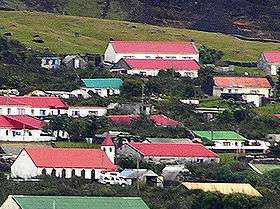
The female descendants have been traced by genetic study to five female founders, believed to be mixed-race (African, Asian and European descent) and from Saint Helena. The historical data recounted that there were two pairs of sisters, but the mtDNA evidence showed only one pair of sisters.[111]
The early male founders originated from Scotland, England, the Netherlands, the United States, and Italy, who belonged to three Y-haplogroups: I (M170), R-SRY10831.2, and R (M207) (xSRY10831.2).[112] The male founders shared nine surnames: Collins, Glass, Green, Hagan, Lavarello, Repetto, Rogers, Squibb, and Swain.[3][lower-alpha 2] In addition, a new haplotype was found that is associated with men of eastern Europe and Russia. It entered the population in the early 1900s, at a time when the island was visited by Russian sailing ships. There is "evidence for the contribution of a hidden ancestor who left his genes, but not his name, on the island."[112] Another four instances of non-paternity were found among male descendants, but researchers believed their fathers were probably among the early island population.[112]
There are eighty families on the island.[114]
Language
Tristan da Cunha's isolation has led to development of its own dialect of English. In popular writing, it has been described by the writer Simon Winchester as "a sonorous amalgam of Home Counties lockjaw and 19th century idiom, Afrikaans slang and Italian."[115][116][lower-alpha 3]
Education
Education is fairly rudimentary; children leave school at age 16, and although they can take GCSEs a year later, few do.[118][119] The school on the island is St. Mary's School, which serves children from ages 4 to 16. The Naval Station had established a school building during World War II. The current facility opened in 1975 and has five classrooms, a kitchen, a stage, a computer room, and a craft and science room.[120] Tristan students doing post-16 education receive assistance from the Tristan da Cunha Association Education Trust Fund and typically do so in the United Kingdom and South Africa.[121]
The Tristan Song Project was a collaboration between St. Mary's School and amateur composers in Britain, led by music teacher Tony Triggs. It began in 2010 and involved St. Mary's pupils writing poems and Tony Triggs providing musical settings by himself and his pupils.[122] A desktop publication entitled Rockhopper Penguins and Other Songs (2010) embraced most of the songs completed that year and funded a consignment of guitars to the school.[123] In February 2013, the Tristan Post Office issued a set of four Song Project stamps featuring island musical instruments and lyrics from Song Project songs about Tristan's volcano and wildlife. In 2014, the project broadened its scope and continues as the International Song Project.
Religion
The only religion is Christianity, with the only denominations being Anglican and Roman Catholic. The Roman Catholic population is served by the Mission Sui Iuris of Saint Helena, Ascension Island and Tristan da Cunha, which is administratively a part of the Apostolic Prefecture of the Falkland Islands
Health
Healthcare is funded by the government, undertaken at most times by one resident doctor. Surgery or facilities for complex childbirth are therefore limited, and emergencies can necessitate communicating with passing fishing vessels so the injured person can be ferried to Cape Town.[124] As of late 2007, IBM and Beacon Equity Partners, co-operating with Medweb, the University of Pittsburgh Medical Center and the island's government on "Project Tristan", has supplied the island's doctor with access to long distance tele-medical help, making it possible to send EKG and X-ray pictures to doctors in other countries for instant consultation.[125]
There are instances of health problems attributed to endogamy, including glaucoma. In addition, there is a very high (42%) incidence of asthma among the population and research by Noe Zamel of the University of Toronto has led to discoveries about the genetic nature of the disease.[126] Three of the original settlers of the island were asthma sufferers.[127]
Culture
Media
Local television began in 1984 using taped programming on Tuesday, Thursday and Sunday evenings.[128] Live television did not arrive on the island until 2001, with the introduction of the British Forces Broadcasting Service, which now provides BBC One, BBC Two, Channel 4, ITV and BFBS Extra, relayed to islanders via local transmitters. Recently the service was upgraded to digital, most TV screens are modern while some older CRT equipments still are in use and there is at least one TV set per house. BFBS Radio 2 is the locally available radio station. An official website is provided by the island government and the Tristan da Cunha Association, which maintains it from the UK.[129] A community newsletter, Village Voice, is produced each week.
Holidays
The island holds an annual break from government and factory work which begins before Christmas and lasts for three weeks. The beginning of the holiday, called Break-Up Day, is usually marked with parties and celebrations.[130]
Notable people
- William Glass (1786-1853), Scottish Corporal and founder of the islands settlement.
- Edwin Heron Dodgson (1846–1918), a clergyman in the Church of England, was the youngest brother of Charles Lutwidge Dodgson (Lewis Carroll), author of Alice's Adventures in Wonderland. He is primarily remembered for his work as a missionary in the island of Tristan da Cunha from 1880–1884.
- Conrad Jack Glass MBE (born 1961) is a Tristanian police officer and a former Chief Islander.[131] He is the first islander to have written a book about it, Rockhopper Copper (2005).[132]
In popular culture
.jpg)
Film
- In Wim Wenders's Wings of Desire, a dying man recollecting the things that have apparently meant most to him mentions "Tristan da Cunha".[133]
- 37°4 S is a short film about two teenagers who live on the island.[134]
Literature
- Edgar Allan Poe's The Narrative of Arthur Gordon Pym of Nantucket (1838), Chapter 15, has a detailed history and description of the island.[135]
- In Jules Verne's novel In Search of the Castaways, one of the chapters is set on Tristan da Cunha, and a brief history of the island is mentioned.[136] The island is also referred to in Verne's novel The Sphinx of the Ice Fields (1897), which he wrote as an unauthorised sequel to Poe's The Narrative of Arthur Gordon Pym of Nantucket. The 1899 English translation by Mrs. Cashel Hoey of Ice Fields was published under the title An Antarctic Mystery.
- South African poet Roy Campbell wrote "Tristan de Cunha" (1927), an elegiac poem about the island.
- Tristan da Cunha is the site of a top-secret nuclear disarmament conference in Fletcher Knebel's 1968 political thriller Vanished. The book was adapted as a 1971 two-part NBC made-for-TV movie starring Richard Widmark.
- Hervé Bazin's novel Les Bienheureux de la Désolation (1970) describes the 1961 forced exile of the population to England after the volcano erupted, and their subsequent return.
- In Primo Levi's memoir The Periodic Table (1975), one of the fictional short stories, "Mercurio", is set on Tristan da Cunha, named "Desolation Island".
- In Patrick O'Brian's novel The Mauritius Command (1977), Tristan da Cunha is mentioned by a man fond of birds, Captain Fortescue of the schooner Wasp, who spent an extended period on the island studying the Albatross whilst cast ashore. Also in O'Brian's The Thirteen-Gun Salute (1991), the ship Dianne is nearly wrecked on Inaccessible Island, with the cover of the book depicting the scene.
- Zinnie Harris's play, Further Than the Furthest Thing (2000), is inspired by events on the island, notably the 1961 volcanic eruption and evacuation of the islanders.
- Raoul Schrott's novel, Tristan da Cunha oder die Hälfte der Erde (2003), is almost entirely set on Tristan da Cunha and Gough islands, and chronicles the history of the archipelago.
- Alice Munro's short story Deep-Holes in her 2009 short story collection Too Much Happiness. The female protagonist, a mother, confides to her young son about her fascination with remote islands like Tristan da Cunha and the Faroe Islands. Later, when her son goes missing, she fantasises that he has found his way to one of these islands and is living there.[137]
- In the book Pulse by Jeremy Robinson, Tristan de Cunha is the top secret headquarters of "Beta Incorporated", a shell company of the antagonistic "Manifold Genetics", which is later destroyed by artificially causing an eruption to self-destruct said base, killing most of the Edinburgh of the Seven Seas population.
- Alf Tupper is a British comic strip. It stars a working class, "hard as nails" runner, Tupper learned that he was born on Tristan da Cunha. Tupper's adventures appeared in The Rover from 1949 and then The Victor, British boys' comics from D.C. Thomson & Co. Ltd. The strip was created by Bill Blaine (probably a pseudonym for William Blaine, head of D.C. Thomson comics), written by Gilbert Lawford Dalton.
Non-fiction
- Frank T. Bullen provides details of visiting the island in the 1870s in his book The Cruise of the Cachalot, first published in 1898.
- Raymond Rallier du Baty describes the people and the island c. 1908 in his book 15,000 Miles in a Ketch (1915).
- In Shackleton's Last Voyage by Captain Frank Wild (1923), several chapters (with photographs) recount events on the island during the Shackleton–Rowett Expedition in May 1922.
- Rose Annie Rogers, part of an American missionary couple, wrote a memoir of her time on Tristan da Cunha, called The Lonely Island (1927).
- Katherine Mary Barrow's book Three Years in Tristan Da Cunha (1910) is a "simple and true description of daily life among a very small community cut off from the rest of the world" based on entries to her diaries and letters written during the period to her sister.
- Martin Holdgate describes a visit to the island by a scientific expedition heading for Gough Island in 1955 in Mountains in the Sea.
- Simon Winchester's book Outposts: Journeys to the Surviving Relics of the British Empire (1985, reprinted in 2003), devotes a chapter to the island, which he visited in the mid-1980s. In the foreword to the reprint, the author states that he was banned from Tristan da Cunha because of his writing about the war-time romance of a local woman. He published a longer account of his banishment in Lapham's Quarterly.[138]
- In 2005, Rockhopper Copper, the first book about the island written by an Islander, was published. It was written by Conrad Glass, Tristan da Cunha's longtime Police and Conservation officer.[139]
- Robert A. Heinlein's book Tramp Royale (1992), about a world trip in 1953–1954, devoted a chapter to his near visit to Tristan da Cunha. He talked to islanders but could not go ashore owing to the weather.
- Arne Falk-Rønne, a Danish travel writer, recorded his impressions of the islands in Back to Tristan (UK: George Allen & Unwin Ltd., 1967), an English translation of Falk-Rønne's original volume in Danish, Tilbage til Tristan (1963).
Notes
- The visit took place during the Duke of Edinburgh's circumnavigation undertaken while commanding HMS Galatea. Tristan da Cunha post office issued four stamps in 1967 to celebrate the centenary of this visit.[23]
- The nine surnames are thought to have been immigrants who were Scottish (Collins, Rogers), Dutch (Glass), English (Green, Squibb, Swain), Irish (Hagan), Italian (Lavarello, Repetto) (both probably Ligurian). A resident surnamed Patterson was briefly on the island.[113]
- Variationist sociolinguistic research involving the language and dialect contact that gave rise to the variety can be found in research by Schrier (2003).[117]
References
- Crawford, Allan (1982). Tristan da Cunha and the Roaring Forties. Charles Skilton. p. 20. Retrieved 13 August 2013.
- "Tristan da Cunha Chief Islander". Tristan da Cunha Government & Tristan da Cunha Association. Archived from the original on 6 September 2014. Retrieved 11 October 2017.
- "Tristan da Cunha Family News". Archived from the original on 28 November 2019. Retrieved 28 November 2019.
- "Census 2016 – summary report" (PDF). St. Helena Government. June 2016. p. 9. Archived (PDF) from the original on 17 October 2016. Retrieved 23 January 2017.
- Winkler, Sarah (25 August 2009). "Where is the Most Remote Spot on Earth? Tristan da Cunha: The World's Most Remote Inhabited Island". How Stuff Works. Retrieved 28 December 2018.
- Rosenberg, Matt (6 March 2017). "Tristan da Cunha: The World's Most Remote Island". ThoughtCo.com. Retrieved 28 December 2018.
- "The St. Helena, Ascension and Tristan da Cunha Constitution Order 2009". The National Archives. 2009. Retrieved 5 January 2019.
- Corne, Lucy. "Tristan da Cunha: a journey to the centre of the ocean". Lonely Planet. Retrieved 9 April 2020.
- Faustini, Arnaldo (14 September 2003). Carrol, Paul (ed.). The Annals of Tristan da Cunha (PDF). Translated by Nysven, Liz; Conrad, Larry. p. 9. Archived (PDF) from the original on 10 May 2015. Retrieved 28 December 2018.
- Headland, J.K. (1989). Chronological list of Antarctic expeditions and related historical events. Cambridge, UK: Cambridge University Press. ISBN 9780521309035. Retrieved 28 December 2018.
- Fontana, Nicolaus (1782). Tagebuch der Reise des k.k. Schiffes Joseph und Theresia nach den neuen österreichischen Pflanzorten in Asia und Afrika. Translated by Eyerel, Joseph. Dessau und Leipzig.
re-published as Pilleri, G., ed. (1982). Maria Teresa e le Indie orientali: La spedizione alle Isole Nicobare della nave Joseph und Theresia e il diario del chirurgo di bordo. Bern, CH: Verlag de hirnanatomischen Institutes. p. 9. - Bolts, Guillaume (1785). Précis de l'Origine, de la Marche et de la Chûte de la Compagnie d'Asie et d'Afrique dans les Ports du Littoral Autrichien. Liege. p. 14.
cited in van Bruyssel, Ernest Jean (1865). Histoire du commerce et de la marine en Belgique. 3. Bruxelles. pp. 295–299.
and cited in Brander, Jan (1940). Tristan da Cunha, 1506-1902. London, UK: Unwin. pp. 49–50.
and cited in article "Charles Proli". Biographie nationale ... de Belgique. Bruxelles. 1905. - Dalrymple, A. A Serious Admonition to the Publick on the Intended Thief Colony at Botany Bay. National Library of Australia. nla.gov.au. London: Sewell. p. n 2. NLA part ID 19595227.
- Frost, Alan (1980). Convicts & Empire: A naval question, 1776–1811. Melbourne: Oxford University Press.
- Blankett, John, Captain R.N. (6 August 1786). "[settlement on Tristan da Cunha]". Letter to Howe. Greenwich: National Maritime Museum. HOW 3.
cited in Frost (1980)[14](pp119,216) - Grenville (3 October 1789). "[general survey of the South Atlantic]". Letter to Admiralty Lords. Public Record Office. ADM 1/4154: 43.
cited in Frost (1980)[14](pp148,220) - Robbins, Helen H. (1908). Our First Ambassador to China. London, UK: Murray. pp. 197–210.
- Mackay, Margaret (1963). Angry Island: The Story of Tristan da Cunha, 1506–1963. London: Arthur Barker. p. 30.
- "Tristan d'Acunha, etc.: Jonathan Lambert, late Sovereign thereof". Blackwood's Edinburgh Magazine. Vol. 4 no. 21. December 1818. pp. 280–285 – via Google Books.
- Roberts, Edmund (1837). Embassy to the Eastern Courts of Cochin-China, Siam, and Muscat. New York: Harper & Brothers. p. 33. Archived from the original on 12 October 2013. Retrieved 11 October 2013.
- Leigh, W. H., esq. (1982) [1839]. Travels and Adventures in South Australia (facsimile ed.). London, UK: The Currawong Press.
- Jan Brander, Tristan da Cunha, 1506-1902, London, Unwin, 1940
- Courtney, Nicholas (2004). The Queen's Stamps. p. 28. ISBN 0-413-77228-4.
- Thomson, C. Wyville (1885). Report on the Scientific Results of the Voyage of H.M.S. Challenger During the Years 1873–76. London, UK: Her Majesty's Stationery Office. pp. 240–252. Retrieved 28 December 2018.
- "H.M.S. Challenger Station 135, Tristan da Cunha". Retrieved 29 August 2016.
- "St. Helena, Ascension, Tristan da Cunha profiles". 14 May 2018. Retrieved 12 January 2020.
- "Tristan da Cunha Isolation & Hardship 1853–1942". Tristan da Cunha Government & Tristan da Cunha Association. Retrieved 1 January 2019.
- "Tristan da Cunha Stamps". Tristan da Cunha. 8 December 2015. Retrieved 2 January 2019.
- Millington, Peter. "Tristan da Cunha News: 1920s Lantern Slides of Tristan for Sale on eBay". Tristan da Cunha. Retrieved 2 January 2019.
- Lawrence, Nigel (8 August 2017). "Tristan Da Cunha". Shipping Today & Yesterday Magazine. Retrieved 2 January 2019.
- "Sale 4010 - Web/Internet - Outgoing Ship Mail". Daniel F. Kelleher Auctions LLC. Retrieved 2 January 2019.
- Wollenberg, Ken (2000). "Chapter XI: Tristan da Cunha". The Bottom of the Map. Bloomington, Indiana: Xlibris. ISBN 9781453565759. Retrieved 28 December 2018.
- "Results of the Norwegian Scientific Expedition to Tristan da Cunha, 1937–1938". OUR Heritage. University of Otago. 1945. Archived from the original on 29 September 2015. Retrieved 3 June 2015.
- Evans, Andrew (22 April 2011). "Holy Grail". National Geographic. Retrieved 2 January 2019.
- Foran, W. Robert (November 1938). "Tristan da Cunha, Isles of Contentment". National Geographic. pp. 671–694.
- "Royal Gifts Gladden 172 on Lonely Atlantic Island". The New York Times. New York, NY. 24 March 1935. second news section, p. N4. Archived from the original on 27 January 2012. Retrieved 15 October 2008.
- "Tristan da Cunha Joining the Modern World 1942–1961". Tristan da Cunha. Retrieved 28 December 2018.
- "hrh the duke of edinburgh's antarctic tour. january 1957". Imperial War Museum. Archived from the original on 2 July 2018. Retrieved 2 July 2018.
- "Tristan da Cunha". Global Volcanism Program. Smithsonian Institution. Retrieved 28 December 2018.
- "Travel Tristan da Cunha". Archived from the original on 11 September 2016. Retrieved 29 August 2016.
- Gila, Oscar Alvarez. "Refugees for the media, evacuees for the government: The 1961 Tristan da Cunha volcano eruption and its displaced inhabitants". Global Change and Resilience: From Impacts to Responses. Brno, Czech Republic.
- "UNESCO Committee Decision 28COM 14B.17". 2004. Archived from the original on 3 January 2019. Retrieved 12 February 2014.
- "Gough Island". Ramsar Sites Information Service. Retrieved 25 April 2018.
- "Inaccessible Island". Ramsar Sites Information Service. Retrieved 25 April 2018.
- Barwick, Sandra (7 June 2001). "120 mph storm devastates Tristan da Cunha". The Daily Telegraph. London, UK. Archived from the original on 22 May 2018. Retrieved 4 April 2018.
- "First postcode for remote UK isle". 7 August 2005. Retrieved 11 June 2020.
- "Factory Fire on 13 February 2008". The Tristan da Cunha Website. Retrieved 5 January 2019.
- "Building a 21st century Tristan fishing factory". The Tristan da Cunha website. Retrieved 5 January 2019.
- "MS Oliva runs aground on Nightingale Island". The Tristan da Cunha Website. Archived from the original on 25 May 2011. Retrieved 23 March 2011.
- "Oil-soaked rockhopper penguins in rehabilitation". BBC News. Archived from the original on 3 September 2013. Retrieved 28 March 2011.
- "Total Solar Eclipse of 2048 December 05". Eclipse.gsfc.nasa.gov. Archived from the original on 11 January 2014. Retrieved 11 January 2014.
- Rosenberg, Mark (6 March 2017). "Tristan da Cunha". ThoughtCo. Retrieved 5 January 2019.
- "Gough Island". South African National Antarctic Programme. Archived from the original on 30 December 2008. Retrieved 25 October 2012.
- "Tristan da Cunha Gough Island". Tristan da Cunha. Retrieved 5 January 2019.
- "ZD9A Gough Island". DX News. 23 June 2016. Retrieved 5 January 2019.
- Kottek, M., J. Grieser, C. Beck, B. Rudolf, and F. Rubel, 2006: World Map of the Köppen-Geiger climate classification updated. Meteorol. Z., 15, 259-263. DOI: 10.1127/0941-2948/2006/0130. http://koeppen-geiger.vu-wien.ac.at/pdf/Paper_2006.pdf
- "Tristan da Cunha Sandy Point". Tristan da Cunha. Retrieved 5 January 2019.
- "South Africa: Tristan Da Cunha". March 2012. Archived from the original on 26 April 2015.
- "Tristan Da Cunha Climate Guide to the Average Weather & Temperatures with Graphs Elucidating Sunshine and Rainfall Data & Information about Wind Speeds & Humidity". March 2012. Archived from the original on 17 November 2011.
- "Tristan da Cunha's Climate".
- Brown, R. N. Rudmose (1905). "The Botany of Gough Island". The Journal of the Linnean Society of London. 37 (259): 238–250, page 242. doi:10.1111/j.1095-8339.1905.TB00834.x.
- Hogan, C. Michael (2009). Stromberg, N. (ed.). "Crown Fern: Blechnum discolor". Globaltwitcher.com. Archived from the original on 13 February 2012.
- Reddy, Simon (22 March 2017). "On a remote archipelago, rich biodiversity faces threats". PewTrusts.org (report). Pew Memorial Trusts. Archived from the original on 27 June 2018. Retrieved 1 April 2020.
- The Vegetation of Tristan Da Cunha,N. M. Wace and M. W. Holdgate, Journal of Ecology Vol. 46, No. 3 (Nov., 1958), pp. 593-620
- http://www.plantsoftheworldonline.org/?q=location%3ATristan+da+Cunha Retrieved at 14.12 on Tuesday 9/6/20
- Gremmen, Niek (2009). "Alien plants and their impact on Tristan da Cunha" (PDF). Brahms Online.
- Law, Jessica (22 October 2018). "Ambitious plan to remove "mega-mice" to save millions of seabirds". Bird Life.
- "Tristan Island". Important Bird Areas. Important Bird Areas factsheet. BirdLife International. 2012. Retrieved 28 December 2018.
- BirdLife International. "Spectacled Petrel". Data Zone. BirdLife Species Factsheet. Retrieved 5 January 2019.
- "Tristan Albatross (Diomedea dabbenena)". BirdLife Data Zone. Retrieved 5 January 2019.
- "Gough Moorhens". Beauty of Birds. Retrieved 5 January 2019.
- Varnham, Karen; et al. (The Royal Society for the Protection of Birds) (2011). "Involving the community in rodent eradication on Tristan da Cunha" (PDF). Island Invasives: 504–507.
- Grundy (15 May 2018). "Tristan da Cunha Wildlife News". Tristandc.com.
- Grundy, Richard (2015). "Tristan da Cunha Wildlife News 2015". Tristandc.com.
- "Tristan da Cunha". National Geographic. February 2017.
- "Cetacea: Whales and Dolphins around the Tristan da Cunha Islands". The Tristan da Cunha Website. Tristan da Cunha Government and the Tristan da Cunha Association. Archived from the original on 4 April 2016.
- Tyler, P. and A. Rothwell. "The Natural History of Tristan da Cunha" (PDF). UK Overseas Territories Conservation Forum. UK Overseas Territories Conservation Forum. Archived from the original (PDF) on 27 May 2015. Retrieved 30 June 2016.
- "Economy of Tristan da Cunha". Tristan da Cunha Government and the Tristan da Cunha Association. June 2005. Archived from the original on 26 May 2012. Retrieved 12 March 2008.
- "OCTA Presentation". octassociation.org. Archived from the original on 27 October 2017. Retrieved 11 October 2017.
- "The Bank of Saint Helena". Sainthelenabank.com. Archived from the original on 15 July 2011. Retrieved 18 April 2010.
- "Tristan da Cunha Coins". The Tristan da Cunha Website. Retrieved 5 January 2019.
- Matzka, Jürgen (20 November 2008). "Danish researchers build magnetic observatory in the middle of the Atlantic Ocean". Technical University of Denmark. Archived from the original on 8 May 2014.
- "Building St. Helena Airport". Archived from the original on 14 October 2017. Retrieved 14 October 2017.
- "St. Helena: Flights to remote Atlantic island begin at last". BBC. Archived from the original on 14 October 2017. Retrieved 14 October 2017.
- "Ascension Island Travel Company". Archived from the original on 26 November 2015. Retrieved 26 November 2015.
- "Last Voyage to Tristan by the RMS St. Helena".
- "Tristan da Cunha's Calshot Harbour". Archived from the original on 12 May 2015. Retrieved 14 August 2015.
- "Global Crossing extends FCO network to Tristan da Cunha". Telecom Paper. 22 May 2006. Archived from the original on 28 July 2013.CS1 maint: BOT: original-url status unknown (link)
- "Tristan Da Cunha Contact Information". Archived from the original on 16 June 2013.
- "Telecommunications expert sets the record straight: Internet access is too expensive for Tristan da Cunha". Tristan da Cunha News. 11 August 2005. Archived from the original on 4 December 2014. Retrieved 28 November 2014.
- "Tristan da Cunha communications news". Archived from the original on 20 July 2015. Retrieved 14 August 2015.
- "Tristan da Cunha's Development and Public Works". Tristan da Cunha Government & Tristan da Cunha Association. 6 October 2016. Archived from the original on 30 April 2018. Retrieved 18 November 2018.
- "ZD9ZS Tristan da Cunha Island". DX News. 9 September 2016. Retrieved 5 January 2019.
- "ZD9ZS – Tristan da Cunha". DX-World. 22 August 2014. Retrieved 5 January 2019.
- "ZD9XF-ZD9ZS Sep 2014: Tristan da Cunha". G3TXF. 9 September 2016. Retrieved 5 January 2019.
- "Saint Helena Dependencies". Statoids.com. Archived from the original on 11 October 2010. Retrieved 18 April 2010.
- "Tristan da Cunha Administrator". Tristan da Cunha. Retrieved 5 January 2019.
- "Tristan da Cunha Government". Tristan da Cunha. Retrieved 5 January 2019.
- "Tristan da Cunha Chief Islander". www.tristandc.com. Retrieved 10 June 2020.
- Rosenberg, Matt (6 March 2018). "Tristan da Cunha". ThoughtCo.com. Retrieved 2 January 2019.
- 1911 Encyclopædia Britannica. 27. Chicago, IL. 1911. p. 295.
- "Tristan da Cunha Isolation & Hardship 1853-1942". Tristan da Cunha. Tristan da Cunha Government & Tristan da Cunha Association. Retrieved 2 January 2019.
- "Answers to Yesterday's Questions". Can You Tell —. Dundee Evening Telegraph. 24 May 1934. p. 7. Retrieved 3 January 2019.
When the French training cruiser, Jeanne d'Arc, recently called at Tristan da Cunha, there were 167 inhabitants living in 40 low-built thatched cottages.
- The Great Soviet Encyclopedia (3rd ed.). 1970–1979.
- "St. Helena, Ascension and Tristan da Cunha". City Population. 6 March 2018. Retrieved 2 January 2019.
- "Tristan Da Cunha". The Columbia Encyclopedia (6th ed.). Retrieved 2 January 2019 – via Encyclopedia.com.
- The Columbia Electronic Encyclopedia. Columbia University Press. 2013.
- "Population Update". Tristan da Cunha Families. Archived from the original on 22 August 2018. Retrieved 24 September 2018.
- Munch, Peter (1970). Crisis in Utopia. New York: Longmans. p. 55. ISBN 978-0582105119.
- Cavendish, Richard (October 2011). "The evacuation of Tristan da Cunha". History Today. Vol. 61 no. 10. Archived from the original on 7 June 2016. Retrieved 25 May 2016.
- Soodyall, H.; Jenkins, T.; Mukherjee, A.; du Toit, E.; Roberts, D.F.; Stoneking, M. (1997). "The founding mitochondrial DNA lineages of Tristan da Cunha Islanders". Am. J. Phys. Anthropol. 104 (2): 157–166. doi:10.1002/(SICI)1096-8644(199710)104:2<157::AID-AJPA2>3.0.CO;2-W. PMID 9386823.
- Soodyall, Himla; Nebel, Almut; Morar, Bharti; Jenkins, Trefor (2003). "Genealogy and genes: Tracing the founding fathers of Tristan da Cunha". European Journal of Human Genetics. 11 (9): 705–709. doi:10.1038/sj.ejhg.5201022. PMID 12939658. Archived from the original on 15 December 2008. Retrieved 25 May 2016 – via nature.com.
- Weaver, Barry (2003). "Tristan da Cunha". College of Atmospheric & Geographic Sciences. University of Oklahoma. Archived from the original on 10 June 2007.
- "Ultimate Remote Tourist Destination: Tristan da Cunha". Sometimes Interesting. 14 March 2012. Retrieved 5 January 2019.
- Winchester, Simon (2003) [1985]. Outposts: Journeys to the surviving relics of the British Empire. p. 87. ISBN 9780141011899. Archived from the original on 25 December 2016. Retrieved 25 December 2016 – via Google Books.
- Bill Bryson documents some examples of the island's dialect in his book, The Mother Tongue.
- Schrier, Daniel (2003). "Tristan da Cunha". Isolation and Language Change. Palgrave Studies in Language Variation (print ed.). London, UK: Palgrave Macmillan. pp. 41–72. doi:10.1057/9780230505261_3. ISBN 978-1-349-50924-9. Schreier, D. (2 May 2003). e-Book / online. ISBN 978-0-230-50526-1.
- Crossan, Rob (11 November 2002). "Return to the Last Outpost". Telegraph Magazine.
- "CNN Traveler: A long way from anywhere". Cnntraveller.com. 1 January 2007. Archived from the original on 29 May 2008. Retrieved 18 April 2010.
- "Tristan School". Tristan da Cunha Government and the Tristan da Cunha Association. Archived from the original on 25 March 2009. Retrieved 21 June 2009.
- "Education in Tristan da Cunha". Tristan da Cunha Government & Tristan da Cunha Association. Retrieved 6 January 2020. — see cited material in the right hand panel
- Triggs, Tony (writing as "Aquila") (July–August 2012), "The Rockhopper songbook", Aquila, pp. 4–5
- SARTMA 19 June 2011
- Bulger, Gerald (11 January 2012). "The most isolated UK GP in the world". GP Online. Archived from the original on 24 December 2016. Retrieved 23 December 2016.
- "IBM connects world's most remote island to health-care". Diagnostic and Interventional Cardiology. 14 November 2007. Retrieved 5 January 2019.
- "Worldwide search for asthma clue". BBC News. 9 December 2008. Archived from the original on 23 November 2011. Retrieved 15 March 2012.
- Mantle, John; Pepys, J. (1974). "Asthma amongst Tristan da Cunha islanders". Clinical & Experimental Allergy. 4 (2): 161–170. doi:10.1111/j.1365-2222.1974.tb01373.x. PMID 4842938. Retrieved 14 August 2015.
- Winchester, Simon (2003) [originally published 1985]. Outposts: Journeys to the Surviving Relics of the British Empire. p. 85.
- "Tristan da Cunha Community News 2005-2011". Tristan da Cunha. Retrieved 6 January 2019.
- "2013–2014 Tristan da Cunha Summer Holiday Christmas and New Years News". Archived from the original on 29 December 2013. Retrieved 29 January 2014.
- "Profile of Conrad Glass Chief Islander 2007–2010". Archived from the original on 6 September 2014. Retrieved 11 October 2017.
- Glass, Conrad J. (2005). Rockhopper Copper: The life and times of the people of the most remote inhabited island on Earth. Leominster: Orphans Press. ISBN 9781903360101.
- "Wings of Desire (1987)". IMDb. Archived from the original on 28 March 2017. Retrieved 15 September 2018.
- "37°4 S (2013)". IMDb. Archived from the original on 12 February 2017. Retrieved 25 October 2018.
- Poe, Edgar Allan (1838). – via Wikisource.
- Verne, Jules (1867–68). – via Wikisource.
- "Everything is funny: A review of Alice Munro's Too Much Happiness". BC BookLook. 16 September 2012.
- "Take Nothing, Leave Nothing: How I came to be banned from the world's most remote island, Tristan da Cunha". Lapham's Quarterly.
- Tristan Times (14 March 2005). "Tristan: Rockhopper Copper set to Hit Bookshelves". Tristan Times. Archived from the original on 7 April 2014. Retrieved 5 April 2014.
Further reading
- Guides
- A Short Guide to Tristan da Cunha by James Glass and Anne Green, Tristan Chief Islanders (2005, Whitby Press, 12 pages).
- Field Guides to the Animals and Plants of Tristan da Cunha and Gough Island Edited by Peter Ryan (2007, RSPB Publication, 168 pages).
- Gough Island: A Natural History by Christine Hanel, Steven Chown and Kevin Gaston (2005, Sun Press, 169 pages).
- Crawford, Allan (1982). Tristan Da Cunha and the Roaring Forties. Anchor Press. ISBN 978-0-2849-8589-7.
- Culture
- Tristan da Cunha: History, People, Language by Daniel Schreier and Karen Lavarello-Schreier (2003, Battlebridge, 88 pages).
- Rockhopper Copper: The life and times of the people of the most remote inhabited island on Earth by Conrad Glass MBE, Tristan Police Officer (2005, Polperro Heritage Press, 176 pages).
- Recipes from Tristan da Cunha by Dawn Repetto, Tristan Tourism Co-ordinator (2010, Tristan Books, 32 pages).
- Corporal Glass's Island: The Story of Tristan da Cunha by Nancy Hosegood (1966, Farrar, Straus, Giroux, 192 pages, with several pages of photographs).
- Three Years in Tristan da Cunha by Katherine Mary Barrow (1910, Skeffington & Son, 200 pages, with 37 photographs).
External links
| Wikimedia Commons has media related to Tristan da Cunha. |
| Wikivoyage has a travel guide for Tristan da Cunha. |
News and government
- Tristan da Cunha – news from the Tristan da Cunha Government and the Tristan da Cunha Association
- Tristan Times – former newspaper
History of the island
- . Encyclopædia Britannica. 27 (11th ed.). 1911.
- History of Tristan da Cunha (2 books, and other material)
- TRISTAN DA CUNHA (Spanish)
- LIFE Magazine article about 1961 evacuation.
Videos of the island
- Return to Trista da Cunha, Global Nomad, National Geographic (2012).
- A Day on Tristan da Cunha, Global Nomad, National Geographic (2011).
- Tristan da Cunha: The story of Asthma Island, part 1 and part 2, BBC Four (2008).
- Tristan da Cunha: Life on the island in 1963 (1963).
- Tristan da Cunha: Life of an islander in 1963 (1963).
